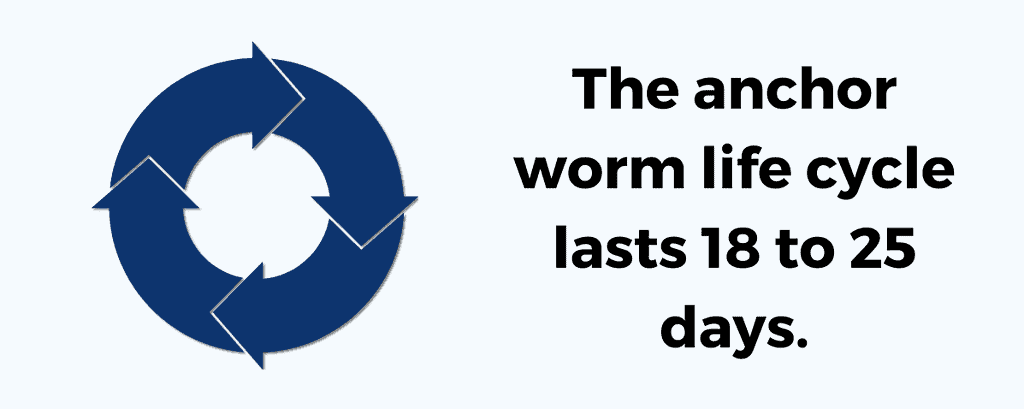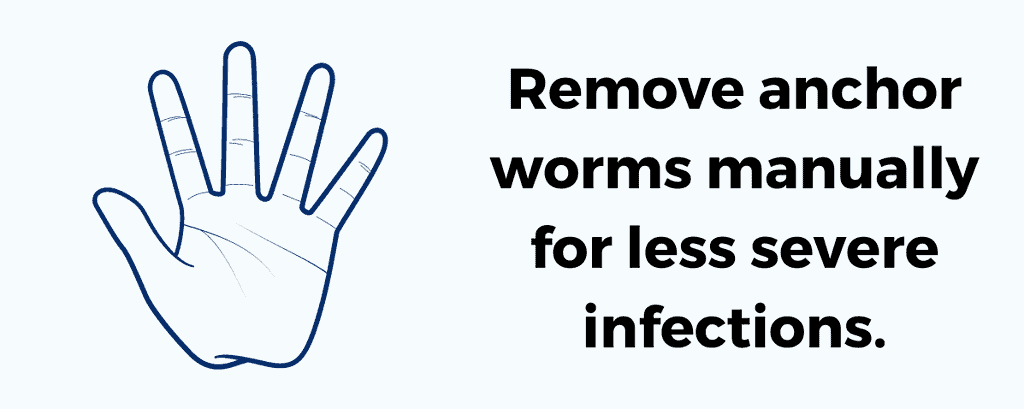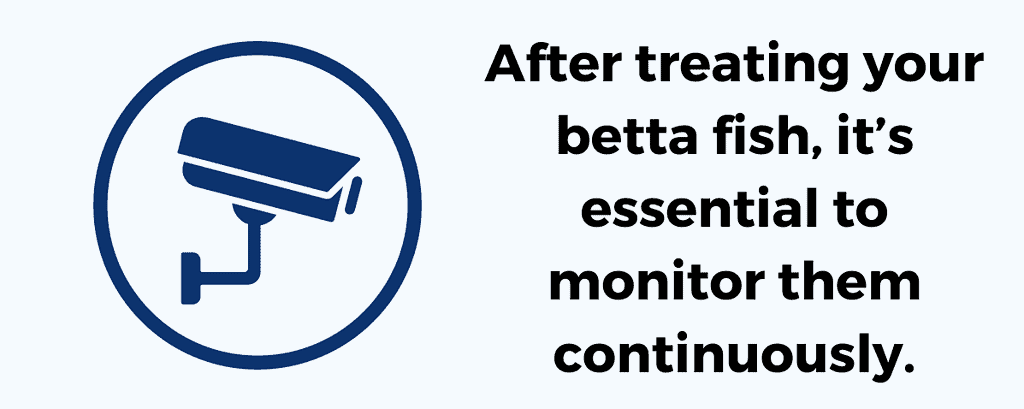Anchor worms are a common parasite found in freshwater aquariums and one of the most common parasites in betta fish.
They’re easily seen with the naked eye and survive by attaching themselves to a fish host. They can cause significant damage to the fish’s flesh and scales if left untreated, so early intervention is critical.
It’s troubling to discover your bettas have become infected with parasites, but there are ways to both prevent and treat this issue.

Table of Contents
Identifying Anchor Worms On Betta Fish

If you suspect your betta fish aquarium has parasites, use the information below to confirm whether or not they’re anchor worms.
What Do Anchor Worms Look Like?
Anchor worms are crustacean copepod parasites with shell-like exteriors. They are considered macroscopic parasites because one can easily see them with the naked eye.
The average anchor worm can grow to be 0.8″ inches long and are typically a pale white color. Another defining feature of anchor worms is their anchor-like head, which they use to sink into your betta’s flesh.
Female anchor worms are identified by their reproductive system, which presents as a worm-like appendage.
Where Are Anchor Worms Found On Betta?
While anchor fish can attach themselves to any part of your betta, these are the most common places to find them:
- Eyes
- Gills
- Mouth
Regularly check your bettas in these areas for signs of an anchor worm infection to prevent massive infestations.
How To Differentiate Anchor Worms From Other Parasites

Compared to other common betta fish parasites, anchor worms have distinctive features:
- Large enough to be seen with the naked eye
- Up to 0.8″ inches long
- Pale white in color
- Anchor-like head
- Worm-like appendage (on females)
We recommend taking it to a vet to ensure your betta receives the correct diagnosis. The vet can more closely examine the parasites and confirm whether they’re anchor worms.
From there, you will be able to take the best course of action to get your betta better.
Importance of Early Identification

Identifying an anchor worm infestation early on is essential, as they can wreak havoc if left unchecked.
The anchor worm life cycle lasts anywhere from 18 to 25 days, and in this time, they can easily take over your fish’s aquarium.
Adult female anchor worms are active egg-layers capable of producing 250 eggs every two weeks.
Additionally, anchor worms in their juvenile stage are invisible to the naked eye. This means your current infestation may be worse than you initially thought.
By identifying an anchor worm infestation from the beginning, you’re keeping these parasites at bay and promoting the health of your tank.
Causes of Anchor Worms On Betta Fish

How Do Anchor Worms Infect Betta?
Once an anchor worm reaches the adult stage of its lifecycle, it must attach itself to a host before dying quickly.
Anchor worms have an appendage on their head resembling an anchor, and they use this appendage to go inside the fish’s flesh and feed.
Female anchor worms, during this stage, also begin laying eggs. They lay their eggs on the host fish, where they later hatch and begin their juvenile free-swimming stage.
If left unchecked, the cycle will continue, and the infestation will quickly become unmanageable.
Common Causes of Anchor Worm Infestations

Several different factors can result in anchor worms being present in the aquarium:
- Bringing new fish into the aquarium. Sometimes, parasites or illnesses are present in store-bought fish. Bringing that fish into the tank can cause the parasites or illness to spread to other fish, causing a full-blown infestation.
- Keeping your bettas in poor-quality water. Parasites like anchor worms have more opportunities to thrive in poor water conditions. This is because it promotes the continued breeding of the parasite and weakens bettas’ immune systems, making them more prone to infection.
- Keeping your bettas in an outdoor environment. Anchor worms are far more common in outdoor fish environments, such as koi ponds or pools. These environments tend to be less controlled and allow anchor worms greater access to the fish.
How To Prevent Anchor Worms From Infecting Betta Fish

To prevent anchor worm infestations, there are a few steps to take.
Perform Frequent Water Changes
Poor water quality is a significant cause of anchor worm infestations. To ensure the health of your bettas, perform frequent water changes to the aquarium.
This helps get rid of any contaminated water, which prevents parasitic infestations. It also helps remove free-swimming juvenile parasites.
Ensure Tank Water is Optimized for Your Bettas
In addition to keeping the tank clean, you must also ensure the tank water is optimized for your bettas.
These beautiful tropical fish require specific water parameters to live and thrive:
Ideal Water Parameters for a Betta Fish Tank Include the following:
- Temperature: 78-80° degrees Fahrenheit (25.5-27° C)
- pH: 6.5-7.5
- Ammonia and Nitrite: 0 ppm
- Nitrate: < 40 ppm
- gH: 3-4 dGH (50-66.7 ppm)
- kH: 3-5 dKH (53.6-89.4 ppm)
- Minimum Tank Size: 5 Gallons
Quarantine Any New Fish You Purchase
A major cause of anchor worm infestations is new fish being added to an aquarium without being quarantined first.
Always quarantine new fish in a separate tank to prevent infestations before adding them to the main tank.
Purchase Only Fish With No Signs of Parasitic Infections
In addition to quarantining new fish, ensure any fish you purchase shows no signs of illness or parasites.
To avoid purchasing an infected fish, examine the fish’s behavior and physical features.
Do not purchase a fish if it appears aggressive, shows flashing behavior, or has typical parasitic infection symptoms—such as clamped fins or dulling color.
Feed Your Bettas a Well-balanced Diet

Malnourished bettas tend to have weaker immune systems and are likelier to become infected with a parasite.
Keep your bettas strong and healthy by feeding them a fiber-rich diet.
Importance of Maintaining Good Water Quality

Good water quality is essential in preventing parasitic infections.
Bettas can only thrive within specific water parameters, and keeping them in subpar water can result in parasitic infections and other health issues.
Parasites have more growth and breeding potential in tanks with poor-quality water.
These conditions allow them to pass unnoticed longer, provide an ideal environment for eggs to hatch, and weaken your bettas’ immune systems.
Perform frequent water changes and regularly monitor your bettas to ensure your aquarium remains free of anchor worms.
Treating Anchor Worms On Betta Fish

If you suspect your aquarium has an anchor worm infestation, you must know your options.
Fish keepers treat Infestations by medication or manually removing the anchor worms from the bettas.
Common medications include:
- Potassium permanganate
- Aquarium salt
- Aquarium salt dip
How To Safely Use Medication To Treat Anchor Worms
Medication treatment only works on juvenile anchor worms, as adult anchor worms are resistant to this type of treatment.
There are three primary options: potassium permanganate, aquarium salt, and aquarium salt dip.
Potassium Permanganate
Potassium permanganate is an artificial substance frequently used to disinfect aquarium decorations and sometimes fish.
It’s quite strong, so it’s critical to use it correctly and in safe doses.

Aquarium Salt
Aquarium salt is a more natural alternative to potassium permanganate.
This substance effectively kills adult and larvae anchor worms, but make sure to use it sparingly.
- Dosage: 1 tablespoon per 5 gallons
- Frequency: 1x per day
Once the infestation is gone, perform a 25% water change daily to remove the remaining aquarium salt.
Aquarium Salt Dip

An aquarium salt dip refers to giving your betta a “salt bath” using a high concentration of aquarium salt. Here’s what you’ll need to do:
- Fill an empty tank or bucket with water. Place an air stone in the tank or bucket, and fill it with water.
- Dose the aquarium salt so the water will be at a 1.5 to 3% salinity.
- Carefully place your betta into the tank or bucket with the aquarium salt.
- Leave your betta in the salt dip bath for 5 to 30 minutes, keeping a close eye on it the whole time.
- Carefully remove your betta from the solution and return it to its original tank.
The aquarium salt dip will help kill off any anchor worms remaining on your betta.
Note: Watch your betta for any signs of distress, such as difficulty breathing, flashing, lethargy, or swimming toward the top of the aquarium salt tank.
If needed, remove it from the salt dip and put it back into its original tank.
Pesticides
There are a few different pesticides available for anchor worm removal. While these chemical treatments are generally effective, none of them are officially approved for this use.
Three of the most common pesticides in this case are trichlorfon, diflubenzuron, and lufenuron:
| Medicine Name | Dosage (Active Ingredient) | Usage |
|---|---|---|
| Trichlorfon | 0.25–0.50 mg/L | Apply 1x per week for 4 weeks |
| Diflubenzuron | 0.03 mg/L | After the first treatment, apply another treatment about two weeks later |
| Lufenuron | 0.1mg/L–0.13 mg/L | Apply 1x per week for 5 weeks |
How To Safely Remove Anchor Worms From the Betta Fish

For less severe parasitic infections, consider removing the anchor worms manually. This method is also more effective for dealing with adult anchor worms.
Because betta fish are rather small and delicate, it’s critical to be cautious while doing so.
To ensure your bettas’ safety, we recommend making a vet appointment and having the vet remove the anchor worms. The vet will remove them using either tweezers or forceps.
Importance of Monitoring the Betta Fish After Treatment

After treating your betta fish, it’s essential to monitor them continuously.
Though rare, anchor worm infestations can occur again if you’re not careful. These are the most common symptoms of an infestation:
- Flashing
- Aggression
- Sores
- Redness
- Breathing difficulties
If you notice these symptoms going forward, check whether the anchor worms have returned and consider making a vet appointment.
How To Prevent Re-infestation

Anchor worms are detrimental to your bettas’ health, but there are ways to prevent another infestation from occurring:
- Frequently perform water changes for your aquarium.
- Only purchase healthy fish.
- Quarantine any new fish in a quarantine tank before introducing them to the main tank.
- Monitor the behavior and status of your bettas.
Don’t Let Anchor Worms Weigh Your Bettas Down

Betta fish require special care to prevent anchor worm infestations, potentially lethal to the fish.
Luckily, anchor worms are easy to spot and identify, and there are several ways to treat infected bettas.
Ensure your fish remain healthy and happy by performing frequent water changes, maintaining water parameters, feeding your bettas well, and watching for signs of illness or distress.
For help in avoiding other dangerous conditions in your betta fish, check out our list and guide at the link.
Commonly Asked Question About Betta Fish With Anchor Worms

How long do anchor worms live on betta fish?
Anchor worms can live on betta fish for roughly 30 days before they die. This is the average lifespan of the adult anchor worm, so they spend their entire adult lives feeding off their host.
Can anchor worms infect other fish in the tank?
Yes, anchor worms can infect other fish in the tank. They spread from fish-to-fish contact, meaning if one betta is infected, the rest will soon be infected as well.
What happens if anchor worms are not treated?
Failing to treat anchor worms will result in the infestation rapidly worsening.
The anchor worms can spread from one fish to another, and the more eggs laid, the more anchor worms there will be to infect your bettas.
In some cases, anchor worm infestations cause illness and even fish death.
Are there any natural remedies to treat anchor worms?
A few natural anchor worm remedies include performing manual water changes, quarantining new fish, and adding aquarium salt to the tank.
However, these methods may not be sufficient for more advanced infestations, and medication may need to be considered.


